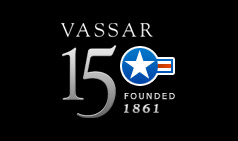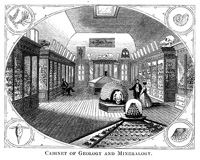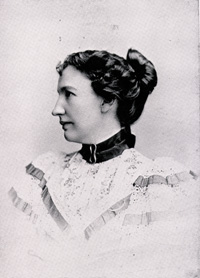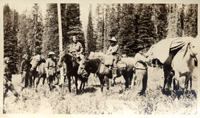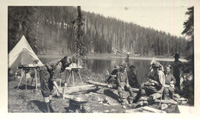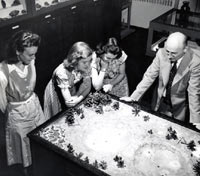The History of Earth Science and Geography at Vassar College
by Harvey K. Flad, Professor Emeritus of Geography
January 2011
Department Website
The Department of Earth Science and Geography has maintained a unique place in the Vassar College curriculum. It is the only department that includes two primary disciplines, and that offer majors degrees in two different divisions: physical sciences and social sciences. Historically, the department has sported a number of name changes, from Natural History to Mineralogy and Geology; Geology and Mineralogy; Geology, Mineralogy and Paleontology; Geography and Geology; Geology and Geography; and since 2006 Earth Science and Geography. The department was a founder of graduate and undergraduate programs in Conservation. Members of the department's faculty have also founded, directed, and taught in the college's interdepartmental and multidisciplinary programs, as well as courses that involved fieldwork in natural environments and cultural landscapes.
Earth science (formerly geology) and geography have been taught at Vassar since the college's opening in 1865. Sanborn Tenney, Vassar's first Professor of Natural History, taught courses in geology, mineralogy, botany, zoology and physical geography. Matthew Vassar had a "cabinet" of mineral and rock specimens installed in 1862, the first sale by the leading supply house in the United States for educational scientific equipment, Ward's Natural Science Establishment in Rochester, New York. After an examination of the specimens and the exhibition of the collection in 1864, two of the most distinguished geologists in the country, James D. Dana and James Hall, wrote to the Trustees that it was "unsurpassed in these respects by any cabinet we are acquainted with in this country or Europe" and was a "scientific collection of great beauty and educational value, which may justly be the pride of the Vassar Female College."
In 1868 James Orton continued teaching geology as part of Natural History. In 1871 Orton instituted the tradition of taking students on extensive field trips during spring break or summer. A member of the class of '74 remembered a field trip to the coal-producing regions of eastern Pennsylvania in 1873, "the girls dressed in their grey flannel gym suits, sat on wooden benches placed for them in a coal car, and traveled two and a half miles underground." Orton died in 1877 while on a trip to Peru collecting bird specimens for the Natural History Museum; forty-four years later in 1921, a monument dedicated to him was constructed on the shore of Lake Titicaca by Vassar alumnae.
From 1878 to1906 William Buck Dwight took his students throughout Dutchess County and collected a number of Cambrian and Ordovician fossils, many of which are type specimens. He also took students on a field trip to the Badlands of South Dakota in 1891 to collect fossils for the museum. Dwight was also responsible for the purchase of a complete skeleton of a mastodon, the core of which was excavated in Circleville, Ohio in 1895. Dwight saw to its placement in the Natural History Museum in Avery in 1902; subsequently, it was installed as the centerpiece of the museum upon its relocation to New England Building in 1918 where it remained until the dismantling of the museum collections in the 1980s.
By the end of the nineteenth century, studies in natural history devolved into distinct disciplines. Under Dwight's supervision, a separate Department of Geology and Mineralogy was established in 1892; it consisted of advanced courses in geology and mineralogy, including paleontology, crystallography and stratigraphy, while physical geography included aspects of climate and oceanography.
Among the Vassar alumnae who had graduated during the nineteenth century, Ellen Churchill Semple, BA 1882 and MA 1891 became the most distinguished American woman geographer of the early twentieth century. Noted for her fieldwork and her studies of geography as a social science and disciplinary relationships with history, she was known as "the greatest anthropogeographer in the world." In a 1915 booklet prepared for the fiftieth anniversary of the opening of the college in 1865, Semple described "Geographical Research as a Field for Women" and exhorted students to "green fields and pastures new, fields as broad as this great continent … fields stretching beyond the ocean and across the eastern hemisphere," to do research that is both humanistic and scientific, "Darwinian in method but Hellenic in form."
The teaching of geography, however, remained associated with natural history, especially geology. At the turn of the century courses in petrology and economic geology were added to the curriculum. Just prior to the arrival of Charles Burbank Shattuck in 1906, the department was named after its primary curricular offerings as the Department of Geology, Mineralogy and Paleontology. Climatology and topographic map-making were added, while upon Shattuck's retirement in 1919, economic and commercial geography were also introduced. A separate Department of Geography and Geology was created in 1920 with Thomas McDougal Hills as Professor of Geology and Chloe Engle as Instructor in Geography. Hills continued the tradition of taking students on field trips to the American West, while Engle and subsequent geographers taught geography as a social science.
Miss Genieve Lamson taught geography as a social science for thirty years beginning in 1922. Both geology and geography were considered "major fields" in 1927, and beginning in 1932 majors could concentrate in either discipline. In 1934 geology and geography separated as geography moved to join social sciences in Blodgett Hall and geology remained in New England Building with the Natural Science Museum and biology. The museum continued to expand with new specimens such as a gift of fossil footprints from the Coconino sandstone of the Grand Canyon from Stephen Mather, first director of the National Park Service. Meanwhile, a Social Museum, instituted in Blodgett Hall, offered displays on national and international economic, political and social developments. Considered a separate department, although not a separate major, courses in geography were accepted in the major fields of economics, sociology, history and political science. Many courses focused on different world regions, while after World War II a course on post-war reconstruction also appeared. 1
When the gymnasium in Ely Hall moved to Kenyon, Ely was remodeled as a classroom and museum space for geology, which moved to its present home in 1936. In 1939-40, Tom Hills completed the wall mural of global physiography that, after repainting in 1977 with plate tectonics, still dominates the building's tower. In 1940-41, Hills constructed a working model of a geyser field that has captured the imaginations of school children for decades. A. Scott Warthin, Jr. had joined Hills in 1929 and continued for over forty years to maintain the mineralogical and fossil collections. The museum is now named in his honor. Warthin specialized in Devonian stratigraphy and was recognized nationally for his work in paleontology as president of the Paleontological Society of America in 1955. After the medical wing vacated Ely for Baldwin House in the 1940s, geology expanded its laboratories into that space.
Warthin also established the first courses in conservation that became the Graduate Division of Conservation. The graduate program integrated four departments of geology, plant science, psychology and zoology that "reaffirmed" the college's "conviction that its studies should be directed toward moral and practical fields." (2) Elizabeth Cushman Titus Putnam established the Student Conservation Association in 1955 after writing her senior thesis for Dr. Warthin, for which they were honored, along with Liz's co-alumna Margaret Hayne Talbot, by the Department of Interior in 1987.
David Lowenthal had replaced Genieve Lamson in 1952 as the sole geographer housed in Blodgett Hall with geography as a separate department, although not as a separate major. Geography was listed as a series of courses in "Related Studies" while geology continued to be a major as a "Central Subject." Lowenthal continued Lamson's close ties to the History Department where the "department" was "administered," and introduced a number of courses that reflected the post-World War II era with titles such as "Modern Imperialism" and "Geography of Underdeveloped Areas." He became an important instructor in a number of Interdepartmental offerings, such as courses on the Soviet Union and the Middle East, the Interdepartmental Related Studies Program in International Relations, as well as the core faculty of the American Culture program, an interdisciplinary program that would be re-established in 1972. Lowenthal arranged for the college to be a depository of the Army Map Service. Its over 40,000 maps, along with a collection of all United States Geological Survey quadrangles and a departmental library, soon commandeered a great deal of space in Ely. These collections later moved to the Thompson Library upon the remodeling and modernizing of Ely Hall in 1992-93.
The geology curriculum solidified in the 1950s as John H. Johnsen joined Scott Warthin in 1951 and Jerome Regnier, who taught for three years in the mid-1950s and again throughout the 1970s. Johnsen and Regnier continued the lapsed tradition of spring break field trips for a dozen years of trips to Puerto Rico, Bermuda and Florida, and Regnier introduced a cross-country field trip during the summer. Johnsen directed Interdepartmental courses on "The River" and "The Hudson River Estuary" that became predecessors to recent interdisciplinary studies of the region and its environmental and human resources. Johnsen was very active in the New York State Geological Association and often brought its annual meetings to the campus; in 1976 his Field Guide to the Hudson River became a benchmark for subsequent field guides to the region.
In 1956, after two years of discussions with the college's curriculum committee on a common interest in conservation, cartography and use of map and library resources, geography was reunited with geology in Ely Hall to become the Department of Geology and Geography. Henceforth, the programs began to coordinate parts of their curriculum, especially those related to physical geography and environmental issues. Meanwhile, geology and biology established an interdepartmental major in conservation until Johnsen's retirement in 1988.
As the geographer in 1956, Elaine Bjorklund taught cartography for both geology and geography students for the next decade, as did John W. Humphrey for the following six years. A joint geology-geography major was established in 1958-59 with a senior seminar taught by instructors from each discipline. Separate majors were reestablished in 1960. When Humphrey left in 1972 the geography major was discontinued, although courses on non-western, urban and socio-economic issues of interest to faculty in the social sciences remained in the curriculum.
To resolve the problem of the loss of the geography major (known as a "concentration"), an interdepartmental geography-anthropology major was created in 1972-73 on the arrival of Harvey Flad. In the late 1970s and early 1980s visiting instructors, including Kenneth Johnson and Jo Margaret Mano, helped to expand geography's curriculum. Mano introduced computers and remote sensing imagery, and in 1982 geography once again became a separate major in its own right. (3) To fulfill the major's curricular requirements, the second full-time, tenure-track geographer, Brian Godfrey, arrived at Vassar in 1985, at which point there were three continuing geologists. Flad emphasized regional geographic fieldwork as a founding member of the multidisciplinary programs in American Culture, Urban Studies and Environmental Studies, while Godfrey continued the emphasis on social geography with courses in ethnic spaces as well as his specialties in Latin America and urban themes that were cross-listed in the Urban Studies and Latin American Studies programs. Correlate sequences were established in land use analysis and regional analysis. With a third tenure-track line in 1991-92, courses on gender began a feminist perspective on geography as a social science, followed by courses on East Asia linked to development of the East Asian Studies program. In 1995 Yu Zhou continued the East Asia and China offerings with a focus on economic geography. Both she and Godfrey forged strong links with the emergent International Studies program and furthered the cartography program.
Cartographic instruction in both geography and geology developed greater emphasis on the use of computer technology throughout the 1980s. Both Mano and Godfrey had begun instruction, followed by Kikongo Ngoy's efforts to introduce Geographic Information System technology in the early 1990s. A GIS laboratory was developed in Ely following Yu Zhou's efforts in the mid-1990s; state-of-the-art technology and instruction continued into the twenty-first century.
Oceanography returned to the curriculum in the 1970s as well as courses in paleoecology. In 1988, Jeff Walker arrived to underscore geology's laboratory and field sciences with courses in mineralogy, crystallography and soils with new lab equipment such as an X-ray diffractometer. Throughout the 1990s, geological and environmental instruction and research required more sophisticated equipment enabling computer-based modeling and magnetic resonance imaging. Additional faculty added further scientific and interdisciplinary depth to the field, including Jill Schneiderman in environmental earth science, gender and ethics; Kirsten Menking in geomorphology, paleoclimatology and hydrology; and Brian McAdoo in geochemistry, earthquakes and oceanography strengthening the geological and earth science components of the department.
In 1998, New York State approved a joint Geography-Geology major. In 2003-04 the name of this major changed to Earth Science and Society to underscore the integration of these two geosciences in studying the earth's physical and human processes. At the beginning of the twenty-first century, computer cartography, GIS and natural resource studies linked the two programs with the addition of Mary Ann Cunningham as the fourth full-time geographer in 2001., The hire of Joe Nevins in social and political geography upon Flad's retirement in 2003-04 consolidated the department at eight full-time members, all of whom became tenured as of 2008-09. Both Earth Science and Geography offer B.A. degrees, while Geography-Anthropology and Earth Science and Society are majors as well.
After a century and a half, the department continues to teach geological, earth and environmental sciences, along with geography as both a physical and social science. Faculty and students focus on the human use of the environment through an ever-changing curriculum, engagement with the college's numerous interdepartmental and multidisciplinary programs, and a commitment to field experience as a critical component of a liberal arts education. Field trips to sites on the Hudson Valley, including Lake Mohonk, Poughkeepsie, New York City and the Adirondacks, as well as further afield, including the American Southwest, U.S./Mexico border, China and Brazil remain as essential to the curriculum as such efforts were in the early decades of the college.
Footnotes:
- 1. The Social Museum, first proposed by Professor of History Lucy Maynard Salmon in 1917 and begun under the direction of Helen Lockwood, Professor of English and founder of the first American Culture Program, held exhibits on many social issues. Genieve Lamson supplied maps, statistics, and other geographical data for exhibits until the museum's demise in 1951.
- 2. Quotation from the Annual Report for Geology for 1940-41, unsigned, although likely written by A. Scott Warthin, who developed the proposal for the conservation program. President MacCracken weighed in as well in his annual report in the Bulletin of Vassar College - Reports of Officers Issue, 1938-39 recognizing gifts from "an anonymous alumna" for lectures, fellowships and an ecology laboratory: "The relation of wild life to forest and other landscape conservation, the contribution of beauty of landscape to human well being, particularly mental well being, the responsibility of women for acting as citizens in defense of the beauty of landscape are all functions of these studies." The history of the establishment of the Student Conservation Association and the role of Elizabeth Titus Putnam can be found at https://www.wilderness.net/index.cfm?fuse=feature0808.
- 3. See Judith Saunders, "Around the World in 80 Ways," Vassar Quarterly (Fall, 1983) for comments about geography and its growth as an academic discipline in the United States during the 1970s and 80s, and the Vassar curriculum, including student projects in the local community.
References:
- Annual Reports for Geology and Geography. Special Collections, Vassar College.
- Barton, Thomas K. and P. P. Karan. 1992. Leaders in American Geography. Mesilla, NM: New Mexico Geographical Society.
- Daniels, Elizabeth A. 1996. Main to Mudd, and More. Poughkeepsie, NY: Vassar College.
- Daniels, Elizabeth A., ed. Vassar Encyclopedia (online). [See especially entries on the Natural History Museum; Mastodon; James Orton; Thomas Hills; and Ellen Churchill Semple]
- Flad, Harvey K. 1998. "Green Fields and Pastures New": The History of Geology and Geography at Vassar College, rev. ed. Poughkeepsie, NY: Vassar College.
- Jones, Rick. 2008. The Evolution of the Natural Sciences: Selections from the Natural History Museum. Poughkeepsie, NY: Vassar College.
- Patkus, Ronald D. and Elizabeth A. Daniels. 2004. An Administrative History of Vassar College, 1861-2003. Poughkeepsie, NY: Vassar College.
- Saunders, Judith. 1983. Around the World in 80 Ways, Vassar Quarterly (Fall), pp. 7-11.
- Wright, Margaret R. 1988. Nineteenth Century Natural History at Vassar College. Poughkeepsie, NY: Vassar College.
